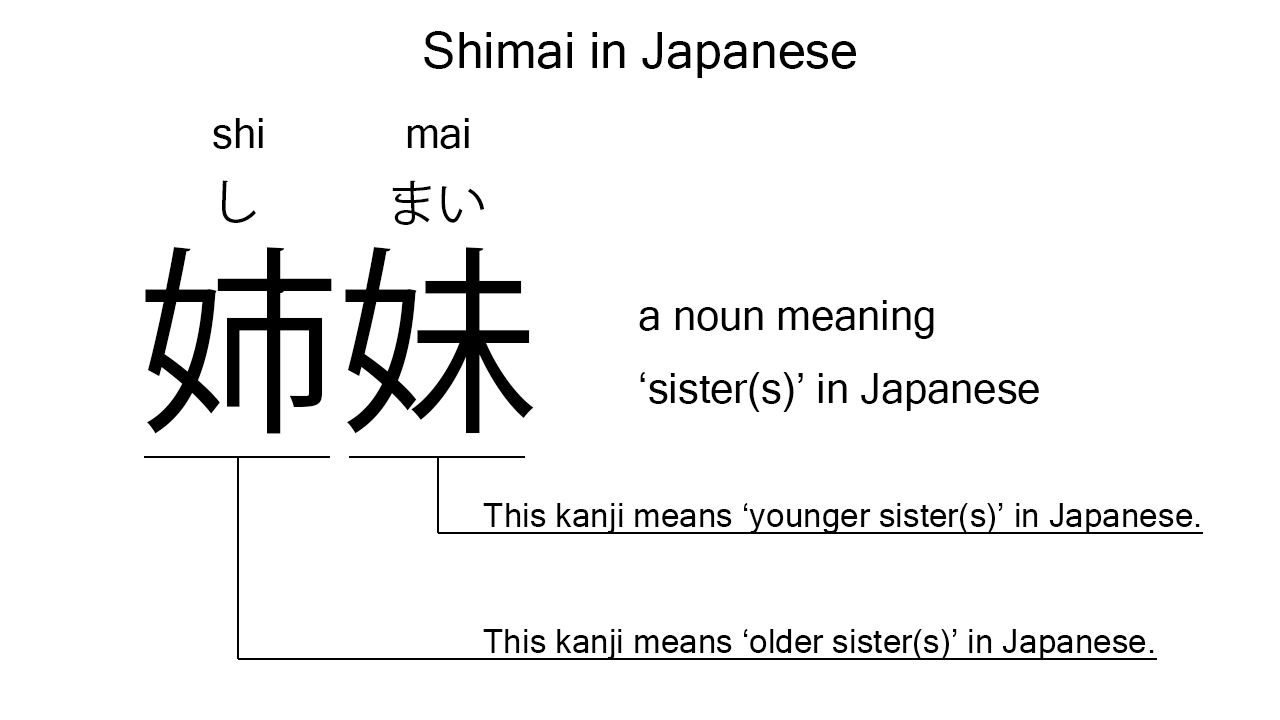What does “shimai” mean in Japanese?
Native speakers say “shimai” to mean ‘sisters’ in Japanese. Perhaps, some Japanese learners know this word as it is sometimes used in Japanese movies, songs, novels, manga, anime, and the like. In this blog post, however, I will explain this word in detail based on its kanji expression. And also, I will explain how to use it through example sentences. My explanations would help Japanese learners understand “shimai” more clearly. Then, let’s get started!
Contents
Definition and meaning of “shimai”
Let me start with the definition and meaning of “shimai”.
- shimai – 姉妹 (しまい) : a noun meaning ‘sisters’ in Japanese. This can also work as singular. Learn more about Japanese plural.
Unlike “kyoudai“, this noun refers only to sisters. So, we can understand that “kyoudai” covers a wider range and plays a more general role in Japanese.
The definition and meaning are simple and clear. To understand this noun more clearly, however, let me explain its kanji characters in detail, one by one.
What does “shimai” literally mean in Japanese?
The kanji expression of “shimai” consists of the following two kanji characters:
- 姉 : a kanji character used to mean ‘older sister’ or ‘elder sister’ in Japanese. This can also be found in other words like “oneechan“.
- 妹 : a kanji character used to mean ‘younger sister’ or ‘little sister’ in Japanese. This can also be found in other words like “imouto“.
These two kanji characters tell us that the formed noun literally means ‘older sisters and younger sisters’ in Japanese. This literal interpretation is not completely in line with the actual meaning, but still very understandable, I think.

When we meet new kanji expressions, we should check their kanji characters in detail to understand their meanings clearly and deeply. In many cases, kanji characters tell us a lot about the meanings of the expressions they form. Actually, here, we could get the better understanding of “shimai” through the detailed kanji check above.
So far, I’ve explained the definition and meaning of “shimai” together with its kanji characters. Then, let me explain how to use it through the example sentences below.
Example #1: how to say “sisters” in Japanese
kanojo tachi wa shimai desu – 彼女達は姉妹です (かのじょたちはしまいです)
They are sisters.
Below are the new words used in the example sentence.
- kanojo – 彼女 (かのじょ) : a pronoun meaning ‘she’ in Japanese.
- tachi – 達 (たち) : a suffix used after a noun or pronoun to make its plural form. In the example, this is used after “kanojo” to make its plural form, “kanojo tachi”, which means ‘they’ in Japanese.
- wa – は : a binding particle working as a case marker or topic marker. In the example, this works after “kanojo tachi” to make the subject in the sentence.
- desu – です : an auxiliary verb used after a noun or adjective to make it polite. Probably, this is well known as a part of Japanese desu form. In the example, this is used after “shimai” to make it sound polite.
This is a typical usage of “shimai”. In the example, it works as the complement in the sentence.
Example #2: another usage of “shimai”
shimai wa totemo utsukushii – 姉妹はとても美しい (しまいはとてもうつくしい)
The sisters are very beautiful.
Below are the new words used in the example sentence.
- totemo – とても : an adverb of degree meaning ‘very’, ‘much’, ‘so’, or such in Japanese. In the example, this works in front of “utsukushii” to emphasize its meaning with adding the meaning of ‘very’.
- utsukushii – 美しい (うつくしい) : an i-adjective meaning ‘beautiful’ in Japanese.
This is another typical usage of “shimai”. In this example, it works together with the binding particle, “wa”, to become the subject in the sentence. When we want to mean ‘sisters’ in Japanese, anyway, this noun is always a very good option.
Summary
In this blog post, I’ve explained the definition and meaning of “shimai” in detail based on its kanji expression. And also, I’ve explained how to use it through the example sentences. Let me summarize them as follows.
- shimai – 姉妹 (しまい) : a noun meaning ‘sisters’ in Japanese. This can also work as singular. Unlike “kyoudai”, this noun refers only to sisters. So, we can understand that “kyoudai” covers a wider range and plays a more general role in Japanese. These two kanji characters literally mean ‘older sisters and younger sisters’ in Japanese. This literal interpretation is not completely in line with the actual meaning, but still very understandable, I think.
Hope my explanations are understandable and helpful for Japanese learners.
Leave a Reply